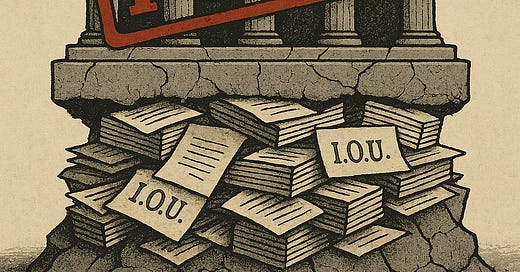Debt Digest | Social Security Isn’t Rife With Fraud—But It’s a (Legal) Ponzi Scheme
Links & Fiscal Facts
Here are this week’s reading links and fiscal facts:
How persistent deficits harm everyday Americans. In a new study, Ernie Tedeschi, director of economics at the Budget Lab at Yale, analyzes the impact of a permanent 1 percent of GDP increase in primary deficits—roughly the cost of extending the expiring Trump tax cuts—on inflation and interest rates. Over five years, if the Fed doesn’t respond, this deficit increase would result in a price level hike equal to a $330-$1,250 (in 2024 dollars) loss of purchasing power for households (figures differ between economic models used). If the Fed reacts to control inflation, “the same 1% of GDP shock leads to higher mortgage interest payments equivalent to $600-1,240 per year in today’s housing market [...]. Meanwhile, real household wealth falls by 1.2% over 5 years (Figure 7), the equivalent of a $14,000 loss on average today (Table 1).” Over 30 years, the Fed’s model shows a 10 percent price level increase, translating to $16,000 in lost purchasing power per household. Rising debt would also raise interest payments—$2,300 more on mortgages, $3,400 on business loans, and $200 on car loans (see graphic below). These estimates illustrate why extensions of the 2017 tax cuts should be paired with offsets—to avoid fueling inflationary pressures and fully unlock their pro-growth potential.
Don’t repeal Social Security benefit taxes. American Enterprise Institute’s Mark J. Warshawsky argues that President Trump’s proposal to eliminate taxation of Social Security benefits “would be costly to the federal budget and the Social Security and Medicare Trust Funds, accelerating their expected exhaustion dates, and it would favor higher-income retirees and workers.” Instead, Warshawsky suggests aligning Social Security benefit taxation with the rules for contributory pensions. “[A beneficiary] would have to pay taxes on the portion [of the total payroll taxes] funded by his employers and any excess of benefits greater than his cost share.” This reform would remove income thresholds that currently exempt some beneficiaries from Social Security benefit taxes. As we’ve noted in the previous Debt Digest edition, more Social Security benefits should be included in taxable income so the tax code treats all income sources similarly and avoids unjustly favoring wealthier seniors.
A new HHS rule could save taxpayers billions. Paragon Health Institute’s Chris Medrano explains that a new rule proposed by the Department of Health and Human Services (HHS) would reduce premiums and lower improper enrollment in the Affordable Care Act exchanges through several changes. These include tightening income verification standards, allowing insurers to deny coverage to people who haven’t paid past premiums, and returning to a fixed enrollment window (Nov 1 - Dec 15) to curb dual enrollments. According to Medrano: “While letting Biden’s COVID enhanced subsidies expire after 2025 is the most potent way to reduce fraud and wasteful ACA-related expenditures, the proposed rule is a strong step toward restoring integrity in the exchanges. HHS estimates that the rule would reduce enrollment by approximately 1.4 million in 2026—largely among those with other coverage or who were fraudulently enrolled—while delivering an estimated $150 billion in taxpayer savings over 10 years. This level of savings directly translates into lower federal debt, interest rates, and inflation.” We’ve also highlighted two Medicaid proposals from the Paragon Institute—eliminating the provider tax loophole and ending the government’s favoritism toward expansion enrollees over traditional beneficiaries—that could save over $1 trillion in 10 years.
The House budget spending cuts aren’t nearly enough to stabilize the debt. The Committee for a Responsible Federal Budget (CRFB) challenges the claim that the House’s proposed spending cuts would be the largest to ever pass Congress. “Assuming the House achieves $1.7 trillion of net spending reductions, it would be the second largest spending cut in nominal terms (after the Budget Control Act of 2011) and – at 0.5 percent of Gross Domestic Product (GDP) – the third largest relative to the size of the economy, going back to 1990 [see figure below],” explains the CRFB. On the other hand, the House budget would increase debt by $3.9 trillion over the next decade, raising the required savings to stabilize debt at 100 percent of GDP from $7.2 trillion to $10.6 trillion. While the House budget includes some savings, much more is needed to put the United States on a sustainable fiscal path.
Social Security isn’t rife with fraud—but it’s a (legal) Ponzi scheme. Brookings Institution’s Darrell M. West argues that Social Security isn’t a Ponzi scheme and debunks some false claims about the program, such as the existence of “millions of dead or fraudulent beneficiaries.” While West is right about the fraud part, Social Security is in fact structured like a Ponzi scheme. As I’ve explained in my recent paper: “Current workers’ payroll taxes fund the benefits of current retirees, much like how Ponzi’s scheme used new money to pay off old promises. While differences exist between the two, this analogy highlights a fundamental truth: Social Security’s ability to make new benefit payments and its sustainability hinge on a steady flow of new contributions. But unlike Ponzi’s fraud, Social Security’s challenges are legal and transparent and rooted in poor program design, economics, and demographic realities.” I break this down further in the video below.







